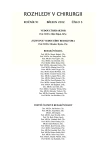Rates of complications after laparoscopic cholecystectomy depending on the coagulation technique – a comparative study
Authors:
P. Hasala
Authors‘ workplace:
Chirurgické oddělení, Nemocnice Přerov, SMN, a. s., primář: MUDr. Stanislav Kalabus
Published in:
Rozhl. Chir., 2012, roč. 91, č. 3, s. 158-163.
Category:
Original articles
Overview
Introduction:
This study analyzes the impact of coagulation instrument devices used during gallbladder removal. Standard electrocautery is compared to the use of harmonic scapel. To determine whether the different principles of these instruments are the key to the frequency and severity of complications during laparoscopy.
Material and methods:
Data collected from a statistically significant number of patients were evaluated and the experiment on porcine liver tissue was conducted to illustrate histopathological changes in tissues after the use of electrocautery and harmonic scalpel.
Results and conclusion:
The presented data and the results of the experiment on animal liver tissue show that the use of harmonic scalpel during gallbladder removal is a safer technique with much lower risk of complications than the use of ordinary electrocautery.
Keywords:
laparoscopy, coagulation, harmonic scalpel, cholecystectomy
Sources
1. A Multitude of Applications – Evidence overview of Harmonic Procedures, Ethicon Endo-Surgery, Johnson & Johnson, 2008.
2. Understanding Harmonic – Ultrasound technology for precise cutting and controlled coagulation, Ethicon Endo-Surgery, Johnson & Johnson 2008.
3. Harmonic Wave – Specifically designed for open surgery, Ethicon Endo-Surgery, Johnson & Johnson 2008.
4. The Year of Energy, EES Generator Gen 11 Nomenclature, Ethicon Endo-Surgery, Johnson & Johnson 2011.
5. Ethicon Endo-Surgery ENSEAL G2, Super Jaw Tissue Sealer, Ethicon Endo-Surgery, Johnson & Johnson 2011.
6. The System of The Future: The Entire Electrosurgical Spectrum in a Modular Single Unit, Erbe 2005.
7. EnSeal PTC – Thermo-intelligent Tissue Vision for Safe, Quick and Precise Dissection, Erbe 2008.
8. Elektrotom 630 – Operating Instructions, Berchtold, 2000.
9. Damani T, Advincula A, Way L. Comparative thermal spread of three radiofrequency bipolar vesel sealing devices, SAGES Congress 2005.
10. Plánování, organizace a hodnocení klinických studií, Institut biostatistiky a analýz, MU Brno, 2008.
11. Analýza klinických dat, Institut biostatistiky a analýz, MU Brno, 2008.
12. Jurka M, Prášek J, Leopold J, Skřička T, Czudek S, et al. Zpráva o 3061 laparoskopických cholecystektomiích, Rozh Chir 1994; 4 : 160–164.
13. Gordon A, Taylor P. Practical Laparoscopy, Blackwell Scientific, 1993 : 12–14.
14. Carus T. Operationsatlas Laparoskopische Chirurgie, Springer, 2010,8 : 22–25.
15. Reuter M, Reuter H, Engel R. History of Endoscopy, Vol. I–IV, 1999 : 405–417.
16. Janssen I, Swank D, et al. Randomized clinical trial of ultrasonic versus electrocautery dissection of the gallbladder in laparoscopic cholecystectomy, British Journal of Surgery 2003;90 : 799–803.
17. Cengiz Y, Jänes A, et al. Randomized clinical trial of traditional dissection with electrocautery versus ultrasonic fundus-first dissection in laparoscopic cholecystectomy, British Journal of Surgery 2005;92 : 810–813.
18. Harold LK, Pollinger BD, et al. Comparison of ultrasonic energy, bipolar thermal energy, and vascular clips for the hemostasis of small-, medium-, and large - sized arteries, Surg Endosc 2003;17 : 1228–1230.
19. Weizman J, Cyriac D, Urbach R. What is meant when a laparoscopic surgical procedure is described as “safe“, Surg Endosc 2007;21 : 1369–1372.
20. Hüscher CG, Lirici M. Laparoscopic cholecystectomy by ultrasonic dissection wirhout cystic duct and artery ligature, Surg Endosc 2003;17 : 442–451.
21. Tsimoyiannis EC. Laparoscopic cholecystectomy using ultrasonically activated coagulating shears, Surg Laparosc Endosc 1998;8 (6):421–424.
22. Hochstadter H. et al. Functional liver damage during laparoscopic cholecystectomy as the sign of the late common bile duct stricture development. Hepatogastroenterology 2003;50 : 676–9.
23. Podnos D, Williams R. Fires in the operating room, Bulletin of the American College of Surgeons, 1997;82(8):7–14.
Labels
Surgery Orthopaedics Trauma surgeryArticle was published in
Perspectives in Surgery

2012 Issue 3
Most read in this issue
- Restoration of active foot extension following peroneal nerve palsy
- Retrogastric bronchogenic cyst
- Osteosynthetic material breakage in patients treated with DHS for proximal femoral fracture
- Screening of breast carcinoma screening in the Czech Republic requires cooperation with surgeons
